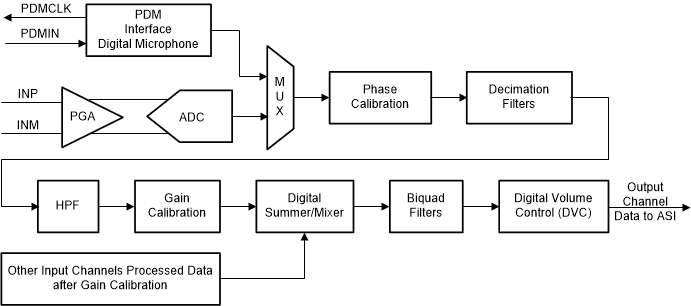SBAA381A April 2019 – January 2024 TLV320ADC3140 , TLV320ADC5140 , TLV320ADC6140
1 Introduction
The TLV320ADCx140/PCMx140-Q1 is a family of quad-channel, audio analog-to-digital converters that includes a highly flexible signal chain with programmable digital processing blocks, making it suitable for a wide variety of applications. The data sheet provides the overview for all of the device features. Figure 1-1 shows the signal processing chain. The device can support four analog microphone channels, 8 digital PDM microphone channels, or a combination of analog and digital microphones channels. The decimation filters, digital summer and mixer block, and bi-quad filters shown in Figure 1-1 are highly configurable, so it can suit different application scenarios. In addition, the device also supports an Automatic Gain Controller (AGC) block and Dynamic Range Enhancer (DRE) block on the analog microphone channels. These digital features all share the same fixed processing resources. Therefore, the number of channels enabled, the nature of each channel (analog or digital), and the sample-rate determine the configuration possibilities for the processing blocks and filters.
 Figure 1-1 TLV320ADCx140/PCMx140-Q1 Channel Signal Chain Processing Flow Chart
Figure 1-1 TLV320ADCx140/PCMx140-Q1 Channel Signal Chain Processing Flow ChartThe TLV320ADCx140/PCMx140-Q1 device family supports two sets of sample rates. One set of sample rates cover the nine submultiples and multiples of 48 kHz, from 8 kHz to 768 kHz. The other set of sample rates cover the sample rates from 7.35 kHz to 705.6 kHz, which are submultiples and multiples of 44.1 kHz. This application note only refers to the set of 48 kHz sample rates, but they are applicable to the corresponding sample rate from the set of 44.1 kHz sample rates. For example, features supported for the 8 kHz sample rate are also supported for 7.35 kHz.
The next section reviews the processing blocks, configuration options and input channels they are supported on, and the supported sample rates. The subsequent section reviews the channel combinations that are supported for different sample rates, and the processing blocks that are supported for the given channel combination.